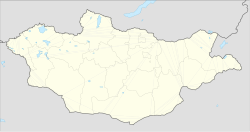Top Qs
Timeline
Chat
Perspective
Arvaikheer
Provincial capital of Övörkhangai Province, Mongolia From Wikipedia, the free encyclopedia
Remove ads
Arvaikheer, also spelt Arwaiheer (Mongolian: Арвайхээр, [arw̜æˑˈçeːr]; "Barley Steppe") is the capital of Övörkhangai Aimag (province) and one of the most central points of Mongolia.



It is a centre for traditional crafts, goat herding and equestrian sports, and hosts a large regional horse festival every year. Arvaikheer has a population of 19,058 (2000 census), 23,298 (2004 est.), 24,954 (2006 est.), 25,622 (2008 est.[1]). Arvaikheer is by far the largest town in the aimag.
Remove ads
Climate
Summarize
Perspective
Arvaikheer has a cold semi-arid climate (Köppen climate classification BSk) with mild summers and relatively mild winters by Mongolian standards. The 30 degrees Celsius difference between average January and average July temperature makes it the mildest place in Mongolia, along with Tsetserleg in Arkhangai Province. It is located in a microclimate in the center of Mongolia which sees less harsh winters than the rest of the country. Its 1,813 metres (5,948 ft) elevation at the foot of the eastern hills of the Khangai Mountains augments its mildness by keeping it distant from cold-air pools in low basins. Most precipitation falls in the summer as rain, with some snow in March, April and October. Winters are very dry.
Remove ads
Administrative divisions
The district is divided into 13 bags, which are:[5]
- Arvaikheer
- Burkhi
- Delgerekh
- Delgerekhiin Denj
- Emt
- Khuis Tolgoi
- Noyon
- Ongi
- Rashaant
- Sogoot
- Ulziit
- Yagaantolgoi
- Zulegt
Transportation
The Arvaykheer Airport has one unpaved runway and is served by regular flights to Ulaanbaatar and Altai. Arvaikheer is linked to Ulaanbaatar by a paved road and can be reached by public buses from the capital.
Sights and infrastructure
Until 1990, Arvaikheer was the headquarters of a large division of the Soviet Army which had a profound influence on daily life in the town.[6] After the fall of Soviet Communism, however, many public buildings were renovated or rebuilt, such as the Sports' Palace in the eastern part of the town. A large park was laid out opposite.
Located about one mile from the central square is Gandan Muntsaglan Khiid, a monastery that was destroyed in 1937 during the purges under Khorloogiin Choibalsan and later reopened in 1991. As of 2008, it housed approximately 60 monks.[7]
Arvaikheer is home to the Museum of Övörkhangai Province, which exhibits fossils and artifacts from the nearby site of Karakorum.[8] Another museum is dedicated to the artist Zanabazar.
Arvaikheer has a large hospital, a kindergarten and various schools and colleges.
Remove ads
References
Wikiwand - on
Seamless Wikipedia browsing. On steroids.
Remove ads



